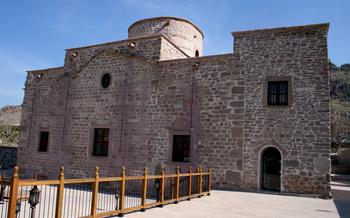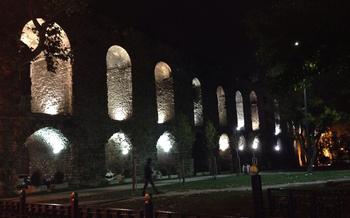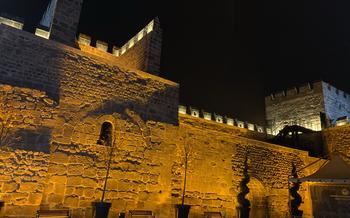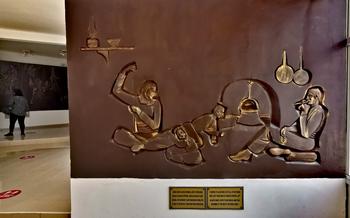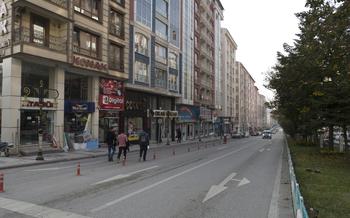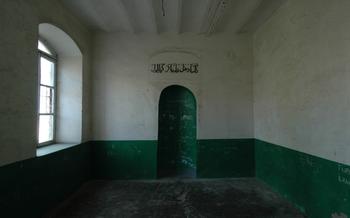
Artova Stone Bridge
- Historical Significance
- Architectural Marvel
- Natural Beauty
- Local Culture and Traditions
- Visitor Experience
- Photography Opportunities
- Historical Context
- Restoration and Preservation
- Local Cuisine
- Festivals and Events
- Accommodation Options
- Transportation
- Safety and Security:
- Insider Tip:
Historical Significance
The Artova Stone Bridge stands as a testament to the rich history and architectural prowess of the Roman era. Built during the 2nd century AD, it played a pivotal role as a vital trade route connecting different regions and facilitating cultural exchange. Its strategic location allowed for the transportation of goods and ideas between the Byzantine Empire and the regions to its east. The bridge's resilience over the centuries is a testament to its engineering marvel, having withstood natural disasters and invasions, remaining a symbol of the region's enduring heritage.
Architectural Marvel
The Artova Stone Bridge stands as a testament to the incredible engineering prowess of the Roman era. Its construction without the use of mortar is a remarkable feat, showcasing the ingenuity and skill of ancient builders. The bridge's multiple arches, each carefully crafted from massive stone blocks, contribute to its stability and resilience. These arches, gracefully spanning the river below, create a sense of rhythm and harmony that is both visually appealing and structurally sound.
Adorning the bridge are intricate decorative elements and inscriptions that add to its aesthetic charm. These embellishments, often featuring floral motifs or geometric patterns, provide a glimpse into the artistic sensibilities of the time. The bridge's timeless design and impressive construction techniques have earned it recognition as a masterpiece of Roman architecture, attracting visitors from around the world who marvel at its enduring beauty and engineering prowess.
Natural Beauty
The Artova Stone Bridge is nestled amidst a breathtaking natural landscape that enhances its allure. Lush greenery surrounds the bridge, with forests and mountains forming a picturesque backdrop. The meandering river that flows beneath the bridge adds to its charm, creating a tranquil and serene atmosphere. The bridge's surroundings transform with the seasons, offering a variety of breathtaking views. In the spring, the landscape bursts into bloom with colorful wildflowers, while the summer sun casts a golden glow on the bridge and its surroundings. Autumn brings vibrant hues of red, orange, and yellow to the forests, creating a stunning contrast against the stone bridge. In the winter, snow blankets the landscape, transforming it into a winter wonderland, with the bridge standing as a majestic landmark amidst the pristine white surroundings.
Local Culture and Traditions
The Artova Stone Bridge is deeply intertwined with the rich cultural heritage and traditions of the region. Over the centuries, it has witnessed countless stories, legends, and customs passed down through generations. Locals hold the bridge in high regard, considering it a symbol of resilience, unity, and community spirit.
One of the most notable traditions associated with the bridge is the annual celebration of its construction. Every year, on a specific date, the community gathers near the bridge for a lively festival filled with music, dancing, and traditional performances. Villagers share stories about the bridge's history, sing folk songs, and engage in friendly competitions. This festival is a testament to the deep bond between the community and their beloved landmark.
Another significant tradition is the practice of leaving offerings on the bridge. Visitors often place small stones or coins on the bridge's surface as a symbol of good luck and prosperity. These offerings are believed to bring blessings to those who leave them and to the community as a whole. The bridge has become a repository of these tokens, representing the hopes and wishes of countless individuals who have crossed its path.
Visitor Experience
Planning a visit to the Artova Stone Bridge promises a rewarding experience for travelers seeking both historical and natural wonders. To make the most of your trip, consider visiting during the spring or fall when the weather is pleasant for outdoor exploration. Take advantage of the opportunity to immerse yourself in the tranquility of the surroundings by engaging in activities like hiking or fishing along the riverbanks. For a deeper cultural experience, explore the nearby villages, where you can interact with locals and discover their way of life. Basic amenities are available for visitor convenience, including parking spaces and restrooms. Guided tours are offered to provide insights into the history and significance of the bridge. Embrace the chance to create lasting memories in this enchanting setting.
Photography Opportunities
The Artova Stone Bridge is a photographer's paradise, offering endless opportunities to capture its beauty and majesty. The bridge's unique architecture, stunning natural surroundings, and historical significance make it an ideal subject for photography enthusiasts.
The best time to photograph the bridge is during the golden hours of sunrise or sunset when the warm light casts a magical glow on the ancient stones. The bridge's reflection in the river below creates a mesmerizing mirror effect, adding depth and drama to your shots.
Experiment with different angles and perspectives to capture the bridge's grandeur. Stand on the bridge itself for a classic shot showcasing its impressive arches and intricate details. Step back and shoot from a distance to capture the bridge in its full glory, surrounded by lush greenery and mountains.
Don't forget to play with different shutter speeds and apertures to create unique effects. A slow shutter speed can blur the flowing water, creating a sense of movement and dynamism. A shallow depth of field can isolate the bridge as the main focal point, blurring the background for a dramatic effect.
Whether you're a seasoned photographer or just starting, the Artova Stone Bridge is a must-visit destination for capturing stunning and memorable images. So bring your camera, unleash your creativity, and let the bridge's timeless beauty inspire your photography.
Historical Context
The Artova Stone Bridge stands as a testament to the rich and storied history of the region. In the Byzantine era, it served as a vital crossing point for trade and communication between the eastern and western parts of the empire. During the Ottoman period, the bridge played a significant role in the region's defense, withstanding numerous sieges and invasions.
The bridge has witnessed countless battles and conflicts over the centuries, each leaving its mark on the structure. In the 19th century, the bridge was the site of a major battle between the Ottoman and Russian armies, resulting in heavy damage to the bridge. Despite its tumultuous past, the Artova Stone Bridge has endured, serving as a reminder of the region's resilience and the enduring legacy of its history.
Restoration and Preservation
The Artova Stone Bridge has stood the test of time, but it has not been without its challenges. Natural wear and tear, as well as the ravages of time and human activity, have taken their toll on this ancient structure. In recent years, concerted efforts have been made to conserve and restore the bridge to its former glory.
Experts in historical preservation have meticulously assessed the bridge's condition and developed a comprehensive restoration plan. Using traditional techniques and materials, they have painstakingly repaired damaged stones, reinforced weakened arches, and addressed structural vulnerabilities. The goal is to maintain the bridge's authenticity while ensuring its stability for future generations.
Organizations such as the Turkish Ministry of Culture and Tourism, along with local authorities and heritage conservation groups, have played a crucial role in these restoration efforts. Their dedication to preserving this historical landmark is a testament to its cultural and historical significance.
By safeguarding the Artova Stone Bridge, we not only protect a tangible piece of history but also preserve a symbol of resilience, engineering prowess, and cultural heritage. It serves as a reminder of the importance of preserving our past for the benefit of future generations.
Local Cuisine
Savory aromas waft through the air as you approach the Artova Stone Bridge, inviting you to explore the culinary delights of the region. Indulge in a feast of traditional Turkish cuisine, where fresh ingredients and vibrant flavors take center stage.
Sample the tantalizing kebabs, grilled to perfection over hot coals, their smoky aroma mingling with the fresh mountain air. Savor the succulent lamb chops, seasoned with aromatic herbs and spices, melting in your mouth with every bite.
Don't miss the gözleme, a specialty of the region. These savory flatbreads are filled with a variety of delicious ingredients, from cheese and spinach to minced meat and vegetables. Pair your meal with a refreshing yogurt drink, ayran, to quench your thirst and balance the flavors.
For a truly authentic experience, visit the local restaurants or cafes near the bridge. Immerse yourself in the warm hospitality of the locals as you savor their culinary creations. Ask for recommendations and be adventurous in trying new dishes and flavors.
Whether you prefer a hearty breakfast, a leisurely lunch, or a delightful dinner, the region surrounding the Artova Stone Bridge offers a culinary journey that will tantalize your taste buds and leave you with lasting memories.
Festivals and Events
The Artova Stone Bridge serves as a backdrop for several festivals and events throughout the year, adding to the region's vibrant cultural scene. One notable event is the annual Artova Stone Bridge Festival, which takes place during the summer months. This festival showcases local traditions, music, dance, and culinary delights. Visitors can indulge in traditional Turkish cuisine, witness colorful performances, and immerse themselves in the lively atmosphere. Another popular event is the Artova Bridge Run, a competitive race that attracts participants from near and far. This event offers a unique opportunity to experience the bridge's history and natural beauty while promoting an active lifestyle. By planning a visit to coincide with these events, travelers can enrich their experience and gain a deeper understanding of the region's cultural heritage.
Accommodation Options
When planning your visit to the Artova Stone Bridge, a range of accommodation options awaits you. From luxurious resorts to budget-friendly guesthouses, there's something to suit every traveler's needs and preferences.
For a truly immersive experience, consider staying in a traditional Turkish guesthouse, known as a "pansiyon." These charming accommodations offer a taste of local culture and hospitality, often run by families who take pride in welcoming guests.
For those seeking comfort and convenience, several modern hotels are located in the vicinity of the bridge. These hotels provide amenities such as comfortable rooms, room service, and easy access to local attractions.
To find the best deals and availability, it's recommended to book your accommodation in advance, especially during peak tourist seasons. Online booking platforms and travel agents can assist you in securing the perfect place to stay during your visit.
Transportation
Reaching the Artova Stone Bridge is a breeze, thanks to the convenient transportation options available. Whether you're traveling from major cities like Istanbul or Ankara, or exploring the region by car, getting to the bridge is easy.
For those arriving by air, the nearest airport is Tokat Airport, located approximately 50 kilometers from the bridge. From the airport, you can take a taxi or rent a car to complete your journey.
If you prefer to travel by land, the Artova Stone Bridge is well-connected by road. The bridge is situated along the D-100 highway, a major artery that runs through the Tokat province. Simply follow the signs to Artova, and you'll find yourself at the bridge in no time.
Public transportation is also an option for reaching the Artova Stone Bridge. Regular bus services connect Tokat city with the town of Artova, where the bridge is located. From Artova, you can take a short walk or taxi to the bridge.
Once you arrive at the bridge, ample parking is available for visitors. Whether you're driving your own car or renting one, you'll have no trouble finding a safe and convenient spot to leave your vehicle while you explore this historical marvel.
Safety and Security:
The Artova Stone Bridge and its surroundings are generally considered safe for travelers. However, as with any destination, it's essential to exercise caution and take necessary precautions. Here are some safety tips for visitors:
- Be aware of your surroundings and be cautious of any suspicious activities or individuals.
- Keep your valuables secure and avoid carrying large amounts of cash.
- Dress respectfully and adhere to local customs and traditions to avoid any misunderstandings or cultural sensitivities.
- If you're exploring the bridge or the surrounding area alone, let someone know your itinerary and expected return time.
- In case of an emergency, dial 112, the universal emergency number in Turkey, to reach the police, ambulance, or fire department.
By following these safety tips, visitors can enjoy a safe and enjoyable experience while exploring the Artova Stone Bridge and its surroundings.
Insider Tip:
For an unforgettable experience, visit the Artova Stone Bridge during the annual "Bridge Festival." Held every summer, this vibrant festival celebrates the bridge's history and cultural significance. Immerse yourself in traditional Turkish music, dance performances, and local artisans showcasing their crafts. Don't miss the mesmerizing fireworks display that illuminates the bridge and the night sky, creating a truly magical atmosphere.

